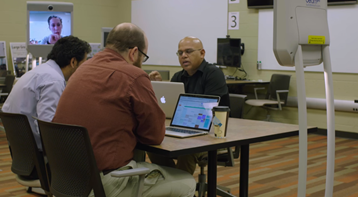
Demand for distance learning, or distance education, where students take online courses or even attend classes virtually, continues to increase. More than one in four students (28%) now take at least one distance education course, according to a recent study conducted by Babson Survey Research Group and co-sponsored by the Online Learning Consortium (OLC).
In response, more and more universities are opening their programs to students via the internet. The problem is, it often comes at the expense of the personal connection and enhanced learning that naturally happens when students sit in a room together, sharing experiences.
John Bell is the head of Michigan State University’s Design Studio and a professor in their doctoral program for educational psychology and educational technology students. As one of the key personnel in driving the department’s shift from an onsite-only program to a hybrid program – where students could attend classes both in-person and remotely – it was important to Bell to find a way to maintain that human connection.
And so began MSU’s foray into remote telepresence exploration. During the next two years, Bell, his students, and the MSU faculty experimented with various types of remote telepresence technology in the classroom. Their findings were fascinating.
“Social presence is what’s so often missing when people attend a class from afar,” says Bell. “With traditional videoconferencing, the remote student has to rely on others to move a laptop or rotate a screen so they can see and hear, and be seen and be heard. It’s inefficient and awkward for the remote student as well as those in the classroom – it’s quite disruptive, actually.”
Bell found that the Beam removed much of this awkwardness, allowing remote students to control when and where they moved and looked in the room, giving them a much more natural and meaningful presence.
Another of MSU’s Professors (who recently moved to be an Associate Dean in the Mary Lou Fulton Teachers College of Arizona State University), Punya Mishra, notes that using robotic telepresence to literally bring all of his research students around the table completely shifts the dynamic. It’s a less formal setting that allows for more personal interactions.
Chris Fahnoe, an Educational Psychology and Educational Technology (EPET) student from Illinois, agrees.
“Early on there was a very large emphasis in the program to make sure that as hybrid students, we were connected in different ways,” Fahnoe says. “This model [Beam] – even in the short time that I’ve had a chance to use it – lends a lot more authenticity. It makes me feel more connected in terms of participation, conversation, and having more control over movement and space.”
While faculty and students alike acknowledge the “coolness factor” that comes with any new technology, and that real adaptation and integration takes time, MSU’s hybrid PhD students are enthusiastic about Beam’s potential.
“If you’re feeling connected and engaged — and it’s natural — then you can do things like professional learning from afar,” adds Fahnoe. “It’s as authentic as if you just met someone you didn’t know, and you’re just talking about what you’re working on.”
Bell believes that robotic telepresence in educational settings is an innovative approach to student participation outside of the classroom, and his students and faculty will continue to explore the technology and its potential.
We applaud MSU’s commitment to improving educational opportunities for students via remote telepresence, and wish them the best in their efforts.
For more on MSU’s cutting-edge pursuit of better distance education, check out this video.